by Edna St. Vincent Millay, (1892-1950) [Pulitzer Prize for Poetry, 1923.]
from Second April (1921):
To what purpose, April, do you return again?
Beauty is not enough.
You can no longer quiet me with the redness
Of little leaves opening stickily.
I know what I know.
The sun is hot on my neck as I observe
The spikes of the crocus.
The smell of the earth is good.
It is apparent that there is no death.
But what does that signify?
Not only under ground are the brains of men
Eaten by maggots.
Life in itself
Is nothing,
An empty cup, a flight of uncarpeted stairs.
It is not enough that yearly, down this hill,
April
Comes like an idiot, babbling and strewing flowers.
and another one from ANNA AKHMATOVA
(Born 1889, Died 1966)
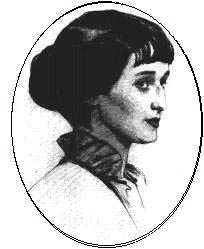
And as it happens often at love's breaking,
The ghost of first days came again to us,
The silver willow through window stretched in,
The silver beauty of her gentle branches.
The bird began to sing a song of light and pleasure
To us, who fear to lift our eyes from the earth,
Who are so lofty, bitter and intense,
About days when we were saved together.
Translated by Yevgeny Bonver, December, 2000
Edited by Dmitry Karshtedt, February, 2001
edited by M. Luesebrink - 2001

Pick up Items - a wonderful review of
the life of Mrs.
Gaskell by Virginia Woolf.
a great essay on the Women Writers of
the Beat Generation -- Women
Beat Writers

Toni Morrison, who you are reading now, ranks as
the only woman writer I can think of who was immediately accepted into the
canon, almost without question, with her work, Song of Solomon.
However, the field of women writers, as we have seen with Virginia Woolf,
Gertrude Stein, Charlotte Perkins Gilman (last
lecture), begins to grow deep and rich as the 20th Century
progresses. Some of this literature falls into the category of
"Domestic Literature" (see the Domestic
Goddesses Page). By the 1950's we have an array of recognized
women writers who are taking exceptional chances with form, and perhaps
more importantly, with subject matter. These women were not
necessarily canonized, but they were certainly blessed with a wide
critical following and with all of the credentials of literary writers.
It is almost impossible to list them all,
although I hope you have a chance to familiarize yourself with the
writings of many of these women in the future. A short list might
include: (you can find links to each of these writers and many others
at
20th
Century Women Writers Page. (This is
just one list, so please check Google Search to find others
of importance!)
here are my personal
favorites:
Isabel Allende (House of the
Spirits)
Margaret Atwood (The
Handmaid's Tale)
Mary Hunter Austin (Land of
Little Rain)
Rita Mae Brown (Rubyfruit
Jungle)
Pearl Buck (The Good Earth)
Carolyn Chute (The Beans of
Egypt, Maine)
Jaon Didion (Slouching Towards
Bethlehem)
Annie Dillard (Pilgrim at
Tinker Creek)
Willa Cather (Death Comes
to the Archbishop)
Charlotte Perkins Gilman (The
Yellow Wallpaper)
Shirley Jackson (The Lottery)
Erica Jong (Fear of Flying)
Ursula K. LeGuin (The Left
Hand of Darkness)
Alice Munro (A Friend of My
Youth)
Anais Nin (Cities of the
Interior)
Flannery O'Connor (Complete
Stories)
Joyce Carol Oates (Wunderland)
Sharon Olds (Collected Poems)
Tillie Olsen (I Stand Here
Ironing)
Dorothy Parker (The Big Blonde)
Sylvia Plath (The Bell Jar)
Anne Sexton (Poems)
Jane Smiley (The Greenlanders)
Eudora Welty
Rebecca West
Laura Ingalls Wilder (Little
House on the Prairie)

Oh, spaghetti!! As soon as
I try to list all the writers who have been influential - who have filled
long nights that would have otherwise been unpleasant or even unbearable
with joy and awe - I realize that it becomes an impossible task after
1950. Women have written such incredible work in the last
half-century. We now have a treasure trove of excellent writing from
women of all countries, classes, and races. Quite surprisingly,
these women have persisted, often writing a substantial body of work, with
all of the professional issues and problems we have investigated in our
earlier lectures. Let me, in desperation, just spend a little time
on a few writers you may have missed. I also choose these writers
because they represent new aspects of the Modern Woman Writer. Two
notable writers who were born in South Africa and became very famous had
little formal education. Another well-known writer turned to
mysteries because she was supporting a family - but what mysteries!
Then, in the second half of class, I would like to concentrate on Flannery
O'Connor - possibly one of the best writers of any century. But now:
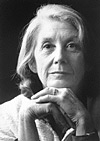 Nadine Gordimer:
Nadine Gordimer:
A Salon
Interview with Nadine Gordimer
South African novelist and short-story writer, who received Nobel Prize for Literature in 1991. Gordimer's works deal with the moral and psychological tensions of her racially divided home country. She was a founding member of Congress of South African Writers, and even at the height of the apartheid regime, she never considered going into exile.
"A line in a statute book has more authority than the claims of one man's love or another's. All claims of natural feeling are over-ridden alike by a line in a statute book that takes no account of humanness, that recognizes neither love nor respect nor jealousy nor rivalry nor compassion nor hate - nor any human attitude where there are black and
white together. What Boaz felt towards Ann; what Gideon felt towards Ann, what Ann felt about Boaz, what she felt for Gideon - all this that was real and rooted in life was void before the clumsy words that reduced the delicacy and towering complexity of living to a race theory..."
(from
Occasion for Loving, 1963)
Nadine Gordimer was born into a well-off family in Springs, Transvaal, an East Rand mining town outside
Johannesburg. It was the setting for Gordimer's first novel, THE LYING DAYS (1953). Her father was a Jewish jeweler originally from Latvia and her mother of British descent. From her early childhood Gordimer witnessed how the white minority increasingly weakened the rights of the black majority. Gordimer was educated in a convent school and she spent a year at Witwaterstrand University, Johannesburg without taking a degree.
Often kept at home by a mother who imagined she had a weak heart, Gordimer began writing from the age of nine and her first story, 'Come Again Tomorrow', appeared in the children's section of the Johannesburg magazine Forum when she was only fourteen. By her twenties Gordimer had had stories published in many of the local magazines and in 1951 the New Yorker accepted a story, publishing her ever since.
From her first collection of short stories, FACE TO FACE (1949), which is not listed in some of her biographies, Gordimer has revealed the psychological consequences of a racially divided society. It was followed by THE SOFT
VOICE OF THE SERPENT (1952), and novel The Lying Days (1953), which was based largely on the author's own life. The story depicted a white girl, Helen, and her growing disaffection toward the narrow-mindlessness of a
small-town life. Other works in the 1950s and 1960s include A WORLD OF STRANGERS (1958), OCCASION FOR LOVING (1963), and THE LATE BOURGEOIS WORLD (1966). In these novels Gordimer studies the
master-servant relations characteristic of South African life, spiritual and sexual paranoias of colonialism, and the shallow liberalism of her privileged white compatriots.
Occasion for Loving was concerned with the 'line in a statute book' - South Africa's cruel racial law. In the story an illicit love affair between a black man and a white woman ends bitterly. Ann Davis is married to a gentle Jew called
Boaz Davis, a dedicated scholar who has traveled all over the country in search of African music. Gideon Shibalo, a talented painter, is black, he has a marriage and several affairs behind. The liberal
Mrs. Jessie Stilwell is a reluctant
hostess to the law-breaking lovers. Boaz, the cuckold, is on the side of the struggling South African black majority, and Ann plays with two men's emotions.
"She looks at them all and cannot believe what she knows: that they, suddenly here in her house, will carry the AK 47s they only sing about, now, miming death as they sing. They will have a career of wiring explosives to the undersides of vehicles, they will go away and come back through the bush to dig holes not to plant trees to shade home, but to
plant
land mines. She can see they have been terribly harmed but cannot believe they could harm. They are wiping their fruit-sticky hands furtively palm against palm."
(from 'Comrades' in Jump, 1991)
Gordimer won early international recognition for her short stories and novels. THE CONSERVATIONIST (1974) juxtaposed the world of a wealthy white industrialist with the rituals and mythology of Zulus. BURGER'S DAUGHTER
(1979) was written during the aftermath of Soweto uprising.
Since 1948 Gordimer has lived in Johannesburg and taught in the USA in several universities during the 1960s and '70s. She has written books of non-fiction on South African subjects and made television documentaries,
notably collaborating with her son Hugo Cassirer on the television film Choosing Justice: Allan Boesak. In THE HOUSE GUN (1998) Gordimer explored the complexities of the violence ridden post-apartheid society through
a murder trial. Two white privileged liberals, Harald and Claudia Lindgard, face the fact that their architect-son, Duncan, has killed his friend Carl Jesperson.
Gordimer's Burger's Daughter (1979) was banned after the Soweto
uprising. Nadine Gordimer
rejected in 1998 the candidacy for Orange Award, because the award was restricted to woman writers. - Only nine women have received (1901-1997) the Nobel Prize for literature: Selma Lagerlof, Sigrid Undset, Grazia
Deledda, Pearl S.Buck, Gabriela Mistral, Nelly Sachs, Toni Morrison, Nadine Gordimer, Wislawa Szymborska
SELECTED BIBLIOGRAPHY:
FACE TO FACE, 1949
THE SOFT VOICES OF THE SERPENT, 1952
THE LYING DAYS, 1953
SIX FEET OF THE COUNTRY, 1956
A WORLD OF STRANGERS, 1958 - Vieraat toisilleen
FRIDAY'S FOOTPRINT ANDOTHER STORIES, 1960
OCCASION FOR LOVING, 1963 - Rakkaus kielletty
NOT FOR PUBLICATION, 1965
LATE BOURGEOIS WORLD, 1966
ed.: SOUTH AFRICAN WRITING TODAY, 1967 (with L.
Abrahams)
GUEST OF HONOUR, 1970
LIVINGSTONE'S COMPANIONS, 1971
THE BLACK INTERPRETERS, 1973
THE CONSERVATIONIST, 1974
SOME MONDAY FOR SURE, 1976
BURGER'S DAUGHTER, 1979 - Burgerin tytär
NO PLACE LIKE, 1979
A SOLDIER'S EMBRANCE, 1980
TOWN AND COUNTRY LOVERS, 1980
JULY'S PEOPLE, 1981 - Palvelija ja herra
SOMETHING OUT THERE, 1984
LIFETIMES: UNDER APARTHEID, 1986
A SPORT OF NATURE, 1987 - Luonnonoikku
THE ESSENTIAL GESTURE, 1988
MY SON'S STORY, 1990 - Poikani tarina
CRIMES OF CONSCIENCE, 1991
JUMP, AND OTHER STORIES, 1991 - Hyppy ja muita novelleja
WHY HAVEN'T YOU WRITTEN? 1992
NONE TO ACCOMPANY ME, 1994 - Ei seuraa matkalleni
WRITING AND BEING, 1995
THE HOUSE GUN, 1998
 Doris Lessing
Doris Lessing 
other
portraits of Doris Lessing
Doris Lessing was born Doris May Taylor in Persia (now Iran) on October 22, 1919. Both of her parents were British: her father, who had been crippled in World War I, was a clerk in the Imperial Bank of Persia; her mother had been a nurse. In 1925, lured by the promise of getting rich through maize farming, the family moved to the British colony in Southern Rhodesia (now Zimbabwe). Doris's mother adapted to the rough life in the settlement, energetically trying to reproduce what was, in her view, a civilized, Edwardian life among savages; but her father did not, and the thousand-odd acres of bush he had bought failed to yield the promised wealth.
Lessing has described her childhood as an uneven mix of some pleasure and much pain. The natural world, which she explored with her brother, Harry, was one retreat from an otherwise miserable existence. Her mother, obsessed with raising a proper daughter, enforced a rigid system of rules and hygiene at home, then installed Doris in a convent school, where nuns terrified their charges with stories of hell and damnation. Lessing was later sent to an all-girls high
school in the capital of Salisbury, from which she soon dropped out. She was thirteen; and it was the end of her formal education.
But like other women writers from southern African who did not graduate from high school
or college (such
as Olive Schreiner and Nadine Gordimer), Lessing made herself into a self-educated intellectual. In flight from her mother, Lessing left home when she was fifteen and took a job as a nursemaid. Her employer gave her books on politics and sociology to read, while his brother-in-law crept into her bed at night and gave her inept kisses. During that time she was, Lessing has written, "in a fever of erotic longing." Frustrated by her backward suitor, she indulged in elaborate romantic fantasies. She was also writing stories, and sold two to magazines in South Africa.
Lessing's life has been a challenge to her belief that people cannot resist the currents of their time, as she fought against the biological and cultural imperatives that fated her to sink without a murmur into marriage and motherhood. "There is a whole generation of women," she has said, speaking of her mother's era, "and it was as if their lives came to a stop when they had children. Most of them got pretty neurotic - because, I think, of the contrast between what they were
taught at school they were capable of being and what actually happened to them." Lessing believes that she was freer than most people because she became a writer. For her, writing is a process of "setting at a distance," taking the "raw, the individual, the uncriticized, the unexamined, into the realm of the general."
In 1937 she moved to Salisbury, where she worked as a telephone operator for a year. At nineteen, she married Frank Wisdom, and had two children. A few years later, feeling trapped in a persona that she feared would destroy her, she left her family, remaining in Salisbury. Soon she was drawn to the like-minded members of the Left Book Club, a group of Communists "who read everything, and who did not think it remarkable to read." Gottfried Lessing was a central
member of the group; shortly after she joined, they married and had a son.
During the postwar years, Lessing became increasingly disillusioned with the Communist movement, which she left altogether in 1954. By 1949, Lessing had moved to London with her young son. That year, she also published her first novel,
The Grass Is Singing, and began her career as a professional writer.
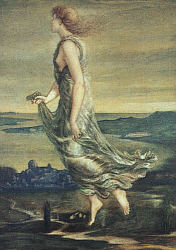
Evening Star, 1870. 52KB Sir Edward Burne-Jones
(1833-1898)
Lessing's fiction is deeply autobiographical, much of it emerging out of her experiences in Africa. Drawing upon her childhood memories and her serious engagement with politics and social concerns, Lessing has written about the clash of cultures, the gross injustices of racial inequality, the struggle among opposing elements within an individuals own personality, and the conflict between the individual conscience and the collective good. Her stories and novellas set in Africa, published during the fifties and early sixties, decry the dispossession of black Africans by white colonials, and expose the sterility of the white culture in southern Africa. In 1956, in response to Lessing's courageous outspokenness, she was declared a prohibited alien in both Southern Rhodesia and South Africa.
Over the years, Lessing has attempted to accommodate what she admires in the novels of the nineteenth century - their "climate of ethical judgement" - to the demands of twentieth-century ideas about consciousness and time. After writing the
Children of Violence series (1951-1959), a formally conventional bildungsroman (novel of education) about the growth in consciousness of her heroine, Martha Quest, Lessing broke new ground with
The Golden Notebook (1962), a daring narrative experiment, in which the multiple selves of a contemporary woman are rendered in astonishing depth and detail. Anna Wulf, like Lessing herself, strives for ruthless honesty as she aims to free herself from the chaos, emotional numbness, and hypocrisy afflicting her generation.
Attacked for being "unfeminine" in her depiction of female anger and aggression, Lessing responded, "Apparently what many women were thinking, feeling, experiencing came as a great surprise." As at least one early critic noticed, Anna Wulf "tries to live with the freedom of a man" - a point Lessing seems to confirm: "These attitudes in male writers were taken for granted, accepted as sound philosophical bases, as quite normal, certainly not as woman-hating, aggressive, or neurotic."
In June 1995 she received an Honorary Degree from Harvard University. Also in 1995, she visited South Africa to see her daughter and grandchildren, and to promote her autobiography. It was her first visit since being forcibly removed in 1956 for her political views. Ironically, she is welcomed now as a writer acclaimed for the very topics for which she was banished 40 years ago.
She collaborated with illustrator Charlie Adlard to create the unique and unusual graphic novel,
Playing the Game. After being out of print in the U.S. for more than 30 years,
Going Home and In Pursuit of the English were republished by HarperCollins in 1996. These two fascinating and important books give rare insight into Mrs. Lessing's personality, life and views.
In 1996, her first novel in 7 years, Love Again, was published by HarperCollins. She did not make any personal appearances to promote the book. In an interview, she describes the frustration she felt during a 14-week worldwide tour to promote her autobiography: "I told my publishers it would be far more useful for everyone if I stayed at home, writing another book. But they wouldn't listen. This time round I stamped my little foot and said I would not move from my house and would do only one interview." And the honors keep on coming: she was on the list of nominees for the Nobel Prize for Literature and Britain's Writer's Guild Award for Fiction in 1996.
December 31 1999: In the U.K.'s last Honours List before the new Millennium, Doris Lessing was appointed a Companion of Honour, an exclusive order for those who have done "conspicuous national service." She revealed she had turned down the offer of becoming a Dame of the British Empire because there is no British Empire. Being a Companion of Honour, she explained, means "you're not called anything - and it's not demanding. I like that". Being a Dame was "a bit pantomimey". The list was selected by the Labor Party government to honor people in
all walks of life for their contributions to their professions and to charity. It was officially bestowed by Queen Elizabeth II. In January, 2000 the National Portrait Gallery in London unveiled Leonard McComb's portrait of Doris Lessing.
Ben, in the World, the sequel to The Fifth Child was published in Spring 2000 (U.K.) and
Summer 2000 (U.S.). Another new novel is planned for next year.
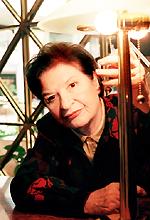 P.D. James
P.D. James
P.D.
James Home Page
Salon
Interview with P.D. James
P.D. James, Phyllis Dorothy James was born in Oxford, England in August 3, 1920.
James was educated at Cambridge Girls High School from 1931 to 1937. Her father did not believe in
higher education for girls; so, at age 16 she was sent out to work in a tax office. A few years later she
found a job as an assistant stage manager at the Cambridge festival Theatre. In 1941 James married
Ernest Connor Bantry White, a physician with whom she had two daughters. She named her second
daughter after her favorite author, Jane Austin.
Conner was sent to India during World War II, and returned from the war mentally disabled. He was
repeatedly hospitalized and finally permanently institutionalized. Connor passed away in 1964.
During all of these years of turmoil it was up to James to be the bread winner of the family. She had
moved in with Connor's parents, sent the girls to boarding school and worked as an administrator in the
national Health Service from 1949 to 1968.
James's experience as an nurse during the war, a mental health administrator, and her contact with
government bureaucracies enabled her to write increasingly philosophical novels. Her writing she says was
an impetus "almost from the time I knew what a book was." She was in her late thirties when she began
her first novel, Cover Her Face---1962.
James stresses that the constant inspiration of her creative imagination is "place".
Her minute and loving elaborations on the descriptions of a place makes her unique
among mystery writers. The format of her novels is a typical English village cozy,
but with acutely observed characters, an atmosphere of menace, medical detail and
great attention to architectural details. Few detective fiction writers have the experience in criminology that
P.D. James has had. She had to support her family, as her husband, a veteran of World War II, had to undergo intense psychotherapy. She worked in London, at first, as a personal secretary at North West Metropolitan Regional Hospital Board, then, later as a civil servant for the Home Office (Criminal Affairs
Department). The recent hostile reactionary movement against the 'typical' Golden Age detective fiction novel, that is, an isolated English manor, wherein traditional English dignity is brusquely threatened by a violent act, explains the originality of some of her books. P.D. James; however, has not always desired to avoid this kind of scene. The sites, somewhat worrying, often the vestiges of the Victorian era, are relatively common sites next
to modern clinics and laboratories
Recommended Reading: Innocent Blood
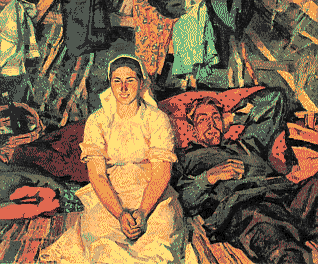


 Nadine Gordimer:
Nadine Gordimer:
 Doris Lessing
Doris Lessing 

 P.D. James
P.D. James

